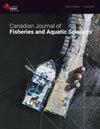农业土地利用和形态计量学解释了加拿大湖泊中营养物质和离子浓度的巨大变化
IF 2.2
2区 农林科学
Q2 FISHERIES
Canadian Journal of Fisheries and Aquatic Sciences
Pub Date : 2023-08-01
DOI:10.1139/cjfas-2023-0109
引用次数: 1
摘要
由于人为的营养物输入造成的淡水质量下降仍然是世界范围内一个持久的问题。然而,我们对大多数湖泊受人类活动(即土地利用/土地覆盖(LULC)变化)影响的程度和规模的了解仍然有限。作为回应,NSERC加拿大湖泊脉动网络在三年多的时间里对12个生态区的664个湖泊进行了调查,编制了第一个全国性的湖泊质量指标系统数据库。为了评估流域发展对水质及其空间变化的影响,我们建立了一般加性模型和多元回归,量化了流域LULC与湖泊温度、Secchi深度、叶绿素-a、限制性营养物质和离子浓度之间的关系。我们发现农业和城市土地利用解释了LULC类别中水质变化的最大比例(R^2 = 0.20-0.29)。总的来说,我们的研究强调,不同地区的水质驱动因素是相似的;然而,基线条件各不相同,因此淡水生态系统管理战略必须考虑其地理环境,以便更好地预测水质阈值将被超越的地方。本文章由计算机程序翻译,如有差异,请以英文原文为准。
Agricultural land use and morphometry explain substantial variation in nutrient and ion concentrations in lakes across Canada
Declines in freshwater quality resulting from anthropogenic nutrient input remain a persistent issue worldwide. Yet, we still have a limited understanding of the magnitude and scale at which most lakes have been affected by human activities, namely Land Use/Land Cover (LULC) alterations. In response, the NSERC Canadian Lake Pulse Network has compiled the first nationwide systematic database of lake quality metrics by surveying 664 lakes across 12 ecozones over three years. To assess the influence of catchment development on water quality and its spatial variation, we built generally additive models and multivariate regressions to quantify the association between watershed LULC and lake temperature, Secchi depth, as well as chlorophyll-a, limiting nutrient, and ion concentrations. We found that agricultural and urban land use explained the greatest proportion of variation in water quality among LULC categories (R^2 = 0.20–0.29). Overall, our study highlights that drivers of water quality are similar across regions; however, baseline conditions vary, so freshwater ecosystem management strategies must consider their geographic context to better predict where water quality thresholds will be surpassed.
求助全文
通过发布文献求助,成功后即可免费获取论文全文。
去求助
来源期刊

Canadian Journal of Fisheries and Aquatic Sciences
农林科学-海洋与淡水生物学
CiteScore
4.60
自引率
12.50%
发文量
148
审稿时长
6-16 weeks
期刊介绍:
The Canadian Journal of Fisheries and Aquatic Sciences is the primary publishing vehicle for the multidisciplinary field of aquatic sciences. It publishes perspectives (syntheses, critiques, and re-evaluations), discussions (comments and replies), articles, and rapid communications, relating to current research on -omics, cells, organisms, populations, ecosystems, or processes that affect aquatic systems. The journal seeks to amplify, modify, question, or redirect accumulated knowledge in the field of fisheries and aquatic science.
 求助内容:
求助内容: 应助结果提醒方式:
应助结果提醒方式:


